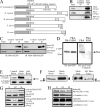The SCF Slimb ubiquitin ligase regulates Plk4/Sak levels to block centriole reduplication
- PMID: 19171756
- PMCID: PMC2654306
- DOI: 10.1083/jcb.200808049
The SCF Slimb ubiquitin ligase regulates Plk4/Sak levels to block centriole reduplication
Abstract
Restricting centriole duplication to once per cell cycle is critical for chromosome segregation and genomic stability, but the mechanisms underlying this block to reduplication are unclear. Genetic analyses have suggested an involvement for Skp/Cullin/F box (SCF)-class ubiquitin ligases in this process. In this study, we describe a mechanism to prevent centriole reduplication in Drosophila melanogaster whereby the SCF E3 ubiquitin ligase in complex with the F-box protein Slimb mediates proteolytic degradation of the centrosomal regulatory kinase Plk4. We identified SCF(Slimb) as a regulator of centriole duplication via an RNA interference (RNAi) screen of Cullin-based ubiquitin ligases. We found that Plk4 binds to Slimb and is an SCF(Slimb) target. Both Slimb and Plk4 localize to centrioles, with Plk4 levels highest at mitosis and absent during S phase. Using a Plk4 Slimb-binding mutant and Slimb RNAi, we show that Slimb regulates Plk4 localization to centrioles during interphase, thus regulating centriole number and ensuring the block to centriole reduplication.
Figures






References
-
- Bettencourt-Dias M., Rodrigues-Martins A., Carpenter L., Riparbelli M., Lehmann L., Gatt M.K., Carmo N., Balloux F., Callaini G., Glover D.M. 2005. SAK/PLK4 is required for centriole duplication and flagella development.Curr. Biol. 15:2199–2207 - PubMed
-
- Boveri T. 1929. The Origin of Malignant Tumors.Williams and Wilkins Co., Baltimore, MD: 119 pp
-
- Brinkley B.R. 2001. Managing the centrosome numbers game: from chaos to stability in cancer cell division.Trends Cell Biol. 11:18–21 - PubMed
Publication types
MeSH terms
Substances
Grants and funding
LinkOut - more resources
Full Text Sources
Molecular Biology Databases

